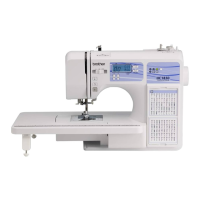
Do you have a question about the Brother HC1850 and is the answer not in the manual?
| Stitch Number | 130 |
|---|---|
| Maximum Sewing Speed | 850 stitches per minute |
| Display | LCD |
| Speed Control | Yes |
| Built-in Memory | No |
| USB Port | No |
| Built-in Sewing Font | 1 |
| Quilting Table | Yes |
| Needle Threader | Automatic |
| Bobbin Type | Drop-in |
| Type | Computerized |
| Presser Feet | 8 |
| Buttonhole Styles | 8 one-step |
Covers electrical hazards, safe operation, and work area safety.
Guidelines for safe sewing practices, handling needles, and child safety.
Precautions for storing, cleaning, and maintaining the machine for longevity.
Important safety guidelines specifically for users in the UK, Eire, Malta, and Cyprus.
Details on accessories included with the machine and those available for purchase.
Location and use of the storage compartment for machine accessories.
Labeling and description of the sewing machine's primary components and their roles.
Guidance on power supply, foot controller, and initial setup for operation.
Step-by-step instructions for winding the bobbin and threading the machine.
Procedure for safely removing and installing sewing machine needles.
Instructions on how to change different presser feet for various sewing tasks.
Basic steps and precautions for operating the sewing machine.
Guide to choosing stitches, adjusting length/width, and starting to sew.
Adjusting thread tension and tips for sewing different fabric types.
Methods for sewing thin, stretch, hook-and-loop, and cylindrical pieces.
Using zigzag, straight, and overcasting stitches for seams and finishing.
Blind hem, buttonhole, zipper, and stretch fabric sewing techniques.
Stitches for appliqué, patchwork, quilting, reinforcement, and decorative patterns.
Tables for utility, mirror image, and character stitch settings and applications.
Chart detailing available character stitches, pattern numbers, and stitch parameters.
Guidelines on machine oiling, proper storage, and surface/component cleaning.
Diagnosing and resolving frequent issues like thread tangles and tension problems.
Understanding machine error codes and audible notifications for operational feedback.